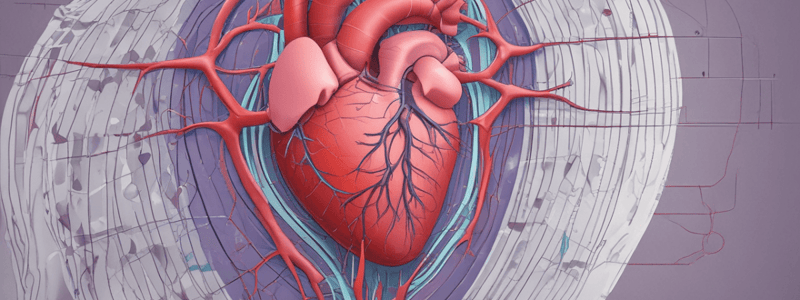Podcast
Questions and Answers
A heart murmur is a hissing noise produced by the heart.
A heart murmur is a hissing noise produced by the heart.
False (B)
Murmurs heard with the naked ear are generally graded as II murmurs.
Murmurs heard with the naked ear are generally graded as II murmurs.
False (B)
A grade III systolic murmur in adults is usually normal.
A grade III systolic murmur in adults is usually normal.
False (B)
Mild mitral valve regurgitation is commonly reported but rarely requires surgical intervention.
Mild mitral valve regurgitation is commonly reported but rarely requires surgical intervention.
A grade IV systolic murmur is always considered normal.
A grade IV systolic murmur is always considered normal.
A systolic ejection click is a clinical clue to the diagnosis of aortic valve replacement.
A systolic ejection click is a clinical clue to the diagnosis of aortic valve replacement.
Aortic regurgitation always presents with a heart murmur.
Aortic regurgitation always presents with a heart murmur.
Mitral Stenosis is characterized by a diastolic rumbling murmur heard at the apex with an opening snap.
Mitral Stenosis is characterized by a diastolic rumbling murmur heard at the apex with an opening snap.
Mitral Valve Prolapse is more commonly seen in adults than in children.
Mitral Valve Prolapse is more commonly seen in adults than in children.
Transesophageal Echocardiography provides better visualization to assess the aortic root when there is aortic regurgitation.
Transesophageal Echocardiography provides better visualization to assess the aortic root when there is aortic regurgitation.
Transthoracic Echocardiography with Doppler is used to assess valve stenosis, valve regurgitation, and cardiac availability.
Transthoracic Echocardiography with Doppler is used to assess valve stenosis, valve regurgitation, and cardiac availability.
Echocardiography is not useful in assessing any valvular, myocardial, pericardial, or congenital heart diseases.
Echocardiography is not useful in assessing any valvular, myocardial, pericardial, or congenital heart diseases.
Aortic sclerosis is the underlying cause of Aortic Stenosis.
Aortic sclerosis is the underlying cause of Aortic Stenosis.
Symptoms of Aortic Stenosis may include dyspnea, decreased exercise tolerance, syncope or dizziness, and angina.
Symptoms of Aortic Stenosis may include dyspnea, decreased exercise tolerance, syncope or dizziness, and angina.
An abnormal systolic murmur heard best in the aortic area indicates aortic regurgitation.
An abnormal systolic murmur heard best in the aortic area indicates aortic regurgitation.
The gradient in echocardiogram for severe stenosis is greater than 50.
The gradient in echocardiogram for severe stenosis is greater than 50.
The natural history of valve lesions in symptomatic individuals is well studied.
The natural history of valve lesions in symptomatic individuals is well studied.
Symptomatic individuals with valve lesions have an ominous prognosis until age 60.
Symptomatic individuals with valve lesions have an ominous prognosis until age 60.
Rheumatic damage to the tricuspid valve can cause mild, moderate, or severe intolerance.
Rheumatic damage to the tricuspid valve can cause mild, moderate, or severe intolerance.
It is essential to perform a postoperative echocardiogram after valve replacement surgery.
It is essential to perform a postoperative echocardiogram after valve replacement surgery.
Mitral stenosis can be caused by congenital stenosis and systemic lupus erythematosus.
Mitral stenosis can be caused by congenital stenosis and systemic lupus erythematosus.
Symptoms of mitral stenosis may include cough and chest regurgitation.
Symptoms of mitral stenosis may include cough and chest regurgitation.
Doppler echo measures only the gradient across the valve but not the pressures.
Doppler echo measures only the gradient across the valve but not the pressures.
Mitral stenosis is a progressive disease with the most common course being stable.
Mitral stenosis is a progressive disease with the most common course being stable.
Mitral regurgitation cases coming to surgery in the last 10 years have had myxomatous disease as the most common cause.
Mitral regurgitation cases coming to surgery in the last 10 years have had myxomatous disease as the most common cause.
Bioprosthetic valves require long-term anticoagulation therapy.
Bioprosthetic valves require long-term anticoagulation therapy.
Survival rates with bioprosthetic valves are slightly worse compared to mechanical valves in the older age groups.
Survival rates with bioprosthetic valves are slightly worse compared to mechanical valves in the older age groups.
Mitral valve prolapse mostly affects females and may require mitral valve repair by age 58.
Mitral valve prolapse mostly affects females and may require mitral valve repair by age 58.
An apical click without a murmur could be an indicator of mitral valve prolapse.
An apical click without a murmur could be an indicator of mitral valve prolapse.
A mitral valve area greater than 0.3cm2 is always indicative of symptoms in patients with MVP.
A mitral valve area greater than 0.3cm2 is always indicative of symptoms in patients with MVP.
Flashcards are hidden until you start studying




